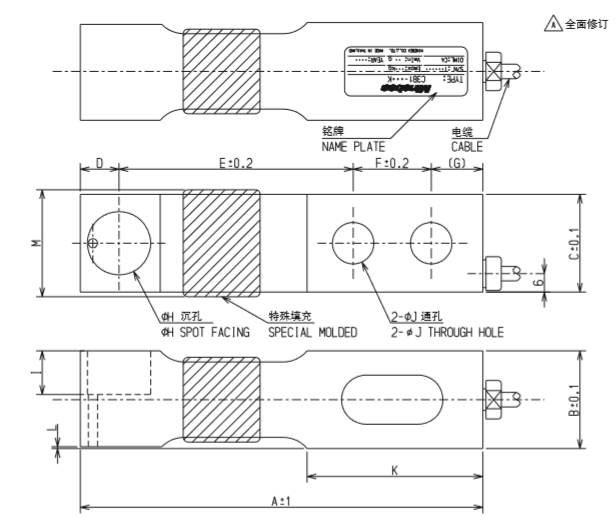Guangzhou Zhongxin Automation Technology Co., Ltd. specializes in supplying the MINIBEA C3B1 series in Japan
Load CellC3B1 sensor C3B1-200k~C3B1-5T_ The Japanese Minebea weighing sensor ensures fast delivery time, 100% genuine, and strives to become the top brand for sensor sales in China. Japanese Minebea C3B1 series load cell related models: C3B1-200kg, C3B1-300kg, C3B1-500kg, C3B1-1ton, C3B1-2ton, C3B1-3ton, C3B1-5ton
The MINIBEA C3B1 sensor from Japan is one of our company's key competitive products, with an absolute advantage in price. It is available in stock, original, authentic, and reliable! Ensure satisfactory price and quality!We solemnly promise: "Within three months, if there are any quality issues, we will unconditionally return or exchange the goods, refund the full payment, and do not charge any fees. 1 year warranty, ready for repair!
Introduction to the Japanese Minebea C3B1 Series
Product brand:
Japan Minebea Load CellProduct abbreviation: Japan C3B1 weighing sensor
Product model: C3B1
Product characteristics:
Bellows weighing sensorProduct principle: Resistance strain gauge
Optional range: 200k~5T
Application scope: Weighing of weighbridge, bucket tank scale, hopper, etc
External dimensions of the Japanese MINIBEA (C3B1) C3B1 series
 JapanMINEBEA(C3B1) C3B1Series specification parameters
JapanMINEBEA(C3B1) C3B1Series specification parameters
Accuracy level C4 based on OIML R60
Maximum load cell scale value 4 000
Model (range) 200K 300K 500K 1T 2T 3T 5T
Rated range 200 kg 300 kg 500 kg 1 ton 2 ton 3 ton 5 ton
Minimum detection scale (Vmin) 20 g 30 g 50 g 100 g 200 g 300 g 500 g
Safety overload 150% R.C
Ultimate overload 200% R.C
Rated output 3 mV/V ± 0.003 mV/V
Nonlinear 0.018% R.O
Hysteresis 0.018% R.O
Repeatability 0.010% R.O
Creep 0.012% R.O./30 min
Creep recovery 0.012% R.O./30 min
Recommended excitation voltage below 10 V
Maximum excitation voltage 20 V
Zero balance ± 0.03 mV/V
Input resistance 380 Ω~460 Ω
Output resistance 345 Ω~355 Ω
Insulation resistance above 2000 M Ω (DC50 V) (between bridge and main body)
Compensation temperature range -10 ℃~40 ℃
Safe temperature range -10 ℃~50 ℃
Effect of temperature change on zero point 0.014% R.O./10 ℃
The impact of temperature changes on output 0.012% LOAD/10 ℃
Cable φ 4.7. With 4-core shielded wire, 6m direct connection, and Y-shaped crimping terminal at the front end
Protection level IP67
Epoxy resin coating (black)
The material of the elastomer is alloy steel
Weight C3B1-200K~C3B1-1T: about 1.1 kg, C3B1-2T~6T: about 2 kg
1 000 000 cycles at rated range of service life
Extended Reading
Performance indicators of weighing sensorsThe performance of a weighing system can be measured by indicators such as linearity, hysteresis, repeatability, and creep.
Linear:Indicates the consistency between the actual output of the system and the theoretical straight line. As shown in the figure, when linear errors occur, the output of the system is correct at no load and full load, but the input-output points between these two points are inconsistent with the ideal state. Linear error is the maximum difference between the theoretical straight line and the actual output curve.
Lag:Indicates the degree to which the input-output curve of the system does not coincide during loading and unloading.
Repeatability:Indicates the degree of inconsistency in the system's output for several consecutive weighing of the same weight during the loading or unloading process. Usually expressed as the percentage of the total output that is the difference between the minimum output and the maximum output of the system under the same loading condition.
Creep:The characteristic of a system that bears a constant weight at a certain temperature, and the output changes over time due to the mechanical deformation of the elastic material of the sensor.
Pressure sensor
Common definitions of
Standard pressure: The amount of pressure expressed in atmospheric pressure. What is greater than atmospheric pressure is called positive pressure; Less than atmospheric pressure is called negative pressure.
Differential pressure (pressure difference): The relative difference between two pressures.
Absolute pressure (A): The amount of pressure expressed in absolute vacuum.
Relative pressure (gauge pressure) (G): Compared to standard pressure. Gauge pressure=absolute pressure - atmospheric pressure.
Atmospheric pressure: refers to the pressure generated by gravity on the air column on the Earth's surface. It is related to the altitude, latitude, and meteorological conditions at which it is located. 1 standard atmospheric pressure (1 atm) is equivalent to the pressure of a mercury column at a height of 760mm.
Vacuum: refers to a pressure state below atmospheric pressure. 1Torr=1/760 atmospheric pressure (atm).
Installation Guidelines for Pressure Sensors
Before installation, please carefully read the product manual and verify the relevant information of the product.
The sensor should be installed in a ventilated, dry, corrosion-free, and cool place. If installed outdoors, a protective cover should be added to avoid the normal use of the product being affected by sunlight and rain.
Avoid strong impact or hitting during installation.
Connect the wires in the correct way and pay attention to protecting the outgoing wires of the sensor.
When cleaning the pressure interface and pilot hole of the sensor, trichloroethylene or alcohol should be injected into the pilot hole, gently shaken, and the liquid poured out multiple times.
It is prohibited to use any hard tool to penetrate the pressure hole to avoid damaging the sensitive core.
The above are [C3B1 sensor] C3B1-200k~C3B1-5T_ Detailed information on the Japanese Minebea weighing sensor, if you are interested in [C3B1 sensor] C3B1-200k~C3B1-5T_ If you have any questions about the price, delivery time, model, and inventory of Minebea weighing sensors in Japan, please feel free to call
18520271262 Chen GongObtain [C3B1 Sensor] C3B1-200k~C3B1-5T_ Latest price details for Minebea weighing sensors in Japan.

